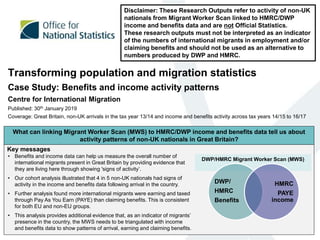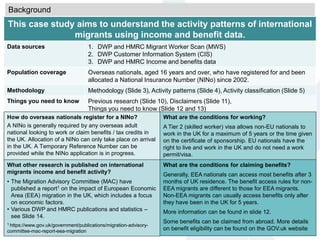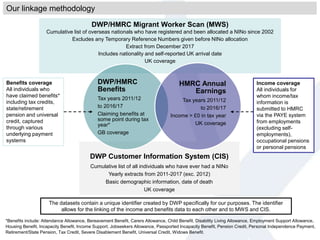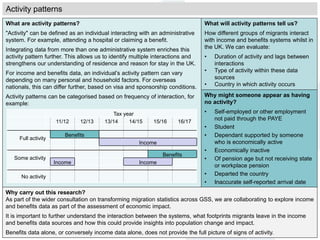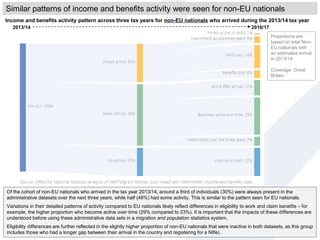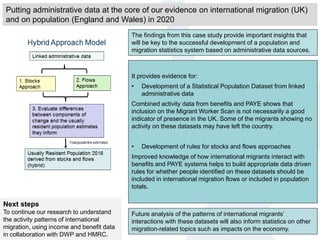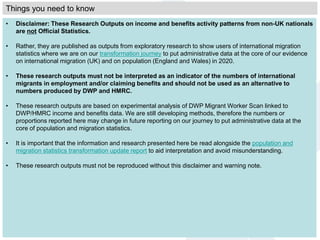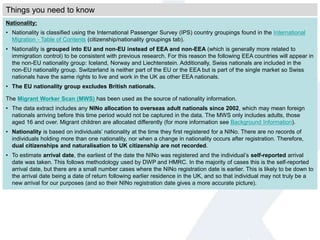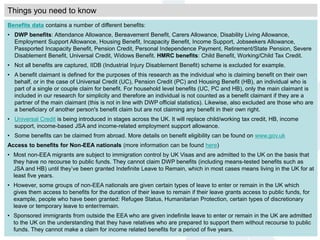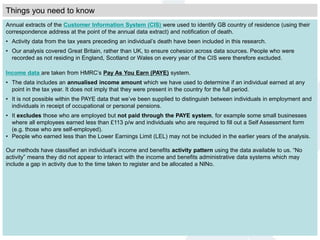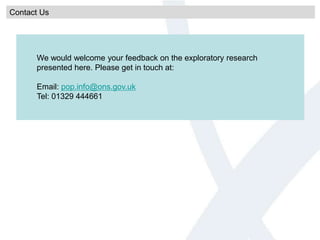Transforming population and migration statistics: Benefits and income activity patterns
- 1. Transforming population and migration statistics Case Study: Benefits and income activity patterns Centre for International Migration Published: 30th January 2019 Coverage: Great Britain, non-UK arrivals in the tax year 13/14 and income and benefits activity across tax years 14/15 to 16/17 Disclaimer: These Research Outputs refer to activity of non-UK nationals from Migrant Worker Scan linked to HMRC/DWP income and benefits data and are not Official Statistics. These research outputs must not be interpreted as an indicator of the numbers of international migrants in employment and/or claiming benefits and should not be used as an alternative to numbers produced by DWP and HMRC. Key messages What can linking Migrant Worker Scan (MWS) to HMRC/DWP income and benefits data tell us about activity patterns of non-UK nationals in Great Britain? • Benefits and income data can help us measure the overall number of international migrants present in Great Britain by providing evidence that they are living here through showing 'signs of activity’. • Our cohort analysis illustrated that 4 in 5 non-UK nationals had signs of activity in the income and benefits data following arrival in the country. • Further analysis found more international migrants were earning and taxed through Pay As You Earn (PAYE) than claiming benefits. This is consistent for both EU and non-EU groups. • This analysis provides additional evidence that, as an indicator of migrants’ presence in the country, the MWS needs to be triangulated with income and benefits data to show patterns of arrival, earning and claiming benefits. DWP/HMRC Migrant Worker Scan (MWS) DWP/ HMRC Benefits HMRC PAYE income
- 2. This case study aims to understand the activity patterns of international migrants using income and benefit data. Data sources 1. DWP and HMRC Migrant Worker Scan (MWS) 2. DWP Customer Information System (CIS) 3. DWP and HMRC Income and benefits data Population coverage Overseas nationals, aged 16 years and over, who have registered for and been allocated a National Insurance Number (NINo) since 2002. Methodology Methodology (Slide 3), Activity patterns (Slide 4), Activity classification (Slide 5) Things you need to know Previous research (Slide 10), Disclaimers (Slide 11), Things you need to know (Slide 12 and 13) What are the conditions for working? A Tier 2 (skilled worker) visa allows non-EU nationals to work in the UK for a maximum of 5 years or the time given on the certificate of sponsorship. EU nationals have the right to live and work in the UK and do not need a work permit/visa. What other research is published on international migrants income and benefit activity? • The Migration Advisory Committee (MAC) have published a report1 on the impact of European Economic Area (EEA) migration in the UK, which includes a focus on economic factors. • Various DWP and HMRC publications and statistics – see Slide 14. 1 https://www.gov.uk/government/publications/migration-advisory- committee-mac-report-eea-migration What are the conditions for claiming benefits? Generally, EEA nationals can access most benefits after 3 months of UK residence. The benefit access rules for non- EEA migrants are different to those for EEA migrants. Non-EEA migrants can usually access benefits only after they have been in the UK for 5 years. More information can be found in slide 12. Some benefits can be claimed from abroad. More details on benefit eligibility can be found on the GOV.uk website Background How do overseas nationals register for a NINo? A NINo is generally required by any overseas adult national looking to work or claim benefits / tax credits in the UK. Allocation of a NINo can only take place on arrival in the UK. A Temporary Reference Number can be provided while the NINo application is in progress.
- 3. *Benefits include: Attendance Allowance, Bereavement Benefit, Carers Allowance, Child Benefit, Disability Living Allowance, Employment Support Allowance, Housing Benefit, Incapacity Benefit, Income Support, Jobseekers Allowance, Passported Incapacity Benefit, Pension Credit, Personal Independence Payment, Retirement/State Pension, Tax Credit, Severe Disablement Benefit, Universal Credit, Widows Benefit. The datasets contain a unique identifier created by DWP specifically for our purposes. The identifier allows for the linking of the income and benefits data to each other and to MWS and CIS. DWP Customer Information System (CIS) Cumulative list of all individuals who have ever had a NINo Yearly extracts from 2011-2017 (exc. 2012) Basic demographic information, date of death UK coverage DWP/HMRC Migrant Worker Scan (MWS) Cumulative list of overseas nationals who have registered and been allocated a NINo since 2002 Excludes any Temporary Reference Numbers given before NINo allocation Extract from December 2017 Includes nationality and self-reported UK arrival date UK coverage DWP/HMRC Benefits Tax years 2011/12 to 2016/17 Claiming benefits at some point during tax year* GB coverage HMRC Annual Earnings Tax years 2011/12 to 2016/17 Income > £0 in tax year UK coverage Benefits coverage All individuals who have claimed benefits* including tax credits, state/retirement pension and universal credit, captured through various underlying payment systems Income coverage All individuals for whom income/tax information is submitted to HMRC via the PAYE system from employments (excluding self- employments), occupational pensions or personal pensions Our linkage methodology
- 4. Why might someone appear as having no activity? • Self-employed or other employment not paid through the PAYE • Student • Dependant supported by someone who is economically active • Economically inactive • Of pension age but not receiving state or workplace pension • Departed the country • Inaccurate self-reported arrival date What are activity patterns? "Activity" can be defined as an individual interacting with an administrative system. For example, attending a hospital or claiming a benefit. Integrating data from more than one administrative system enriches this activity pattern further. This allows us to identify multiple interactions and strengthens our understanding of residence and reason for stay in the UK. For income and benefits data, an individual’s activity pattern can vary depending on many personal and household factors. For overseas nationals, this can differ further, based on visa and sponsorship conditions. Activity patterns can be categorised based on frequency of interaction, for example: Tax year 11/12 12/13 13/14 14/15 15/16 16/17 Full activity Benefits Income Some activity Benefits Income Income No activity What will activity patterns tell us? How different groups of migrants interact with income and benefits systems whilst in the UK. We can evaluate: • Duration of activity and lags between interactions • Type of activity within these data sources • Country in which activity occurs Why carry out this research? As part of the wider consultation on transforming migration statistics across GSS, we are collaborating to explore income and benefits data as part of the assessment of economic impact. It is important to further understand the interaction between the systems, what footprints migrants leave in the income and benefits data sources and how this could provide insights into population change and impact. Benefits data alone, or conversely income data alone, does not provide the full picture of signs of activity. Activity patterns
- 5. Income and benefits activity over 2014/15, 2015/16 and 2016/17 What does the activity group mean? Always Active Always active on both Claiming benefits and earning and taxed through PAYE in every tax year PAYE only Earning and taxed through PAYE in each tax year and no benefit claims made Intermittent activity across both Interaction with one of the data sources across every tax year and sporadic interaction with the other data source Benefits only Claiming benefits in each tax year and no interaction with PAYE Some Activity Active after arrival Claiming benefits and/or earning and taxed through PAYE in at least the first tax year after arrival but activity stops before the end of the period. Becomes active over time No activity in first tax year(s) followed by information showing claiming benefits and/or earning and taxed through PAYE in the last tax year(s) Intermittent over the three years Activity with income and benefits data at the beginning and end of the period or only in the middle tax year Classifying income and benefits activity patterns As an illustration of our research, we took a cohort of non-UK nationals with an estimated arrival during the 2013/14 tax year and looked across their income and benefits activity over the next three tax years. This cohort provided a substantial number of both EU and non-EU nationals to allow further disaggregation. Future work is planned to extend this analysis to further cohorts and look at activity over longer periods. Firstly the information was classified into the following high level categories: 1. Always Active: Claiming benefits and/or earning and taxed through PAYE in all three tax years 2. Some Activity: Claiming benefits and/or earning and taxed through PAYE in at least one but not all three tax years 3. No Activity: Not claiming benefits and not earning and taxed through PAYE in all three tax years In addition, more detailed activity groups were created looking at interactions from both data sources over each tax year: What was the activity for non-UK nationals in our cohort? We found that 4 in 5 non-UK nationals had activity (always or some) in the income and benefits data. The largest activity group (25%) were those that became active over time. Another large group were non-UK nationals who were earning and taxed through PAYE in every tax year and did not claim benefits (19%).
- 6. 2013/14 2016/17 Income and benefits activity pattern across three tax years for EU nationals who arrived during the 2013/14 tax year Of our cohort of EU nationals who arrived in the tax year 2013/14, 35% had activity in the income and benefits administrative data sets in all three of the following tax years, while a further 45% had some activity over the same period. More detailed analysis will allow us to understand more fully the different patterns and combinations of activity across the two datasets. A total of 1 in 5 people had no activity recorded over the three years. These people could be students, self-employed, dependants, economically inactive or people who have since left the country without interacting with either system. Identifying inactivity in administrative datasets provides important information for research into approaches for measuring emigration. Most EU nationals have activity on benefits or PAYE systems in the 3 tax years after arrival Proportions are based on total EU nationals with an estimated arrival in 2013/14 Coverage: Great Britain
- 7. Of the cohort of non-EU nationals who arrived in the tax year 2013/14, around a third of individuals (30%) were always present in the administrative datasets over the next three years, while half (48%) had some activity. This is similar to the pattern seen for EU nationals. Variations in their detailed patterns of activity compared to EU nationals likely reflect differences in eligibility to work and claim benefits – for example, the higher proportion who become active over time (29% compared to 23%). It is important that the impacts of these differences are understood before using these administrative data sets in a migration and population statistics system. Eligibility differences are further reflected in the slightly higher proportion of non-EU nationals that were inactive in both datasets, as this group includes those who had a longer gap between their arrival in the country and registering for a NINo. Income and benefits activity pattern across three tax years for non-EU nationals who arrived during the 2013/14 tax year Similar patterns of income and benefits activity were seen for non-EU nationals 2013/14 2016/17 Proportions are based on total Non- EU nationals with an estimated arrival in 2013/14 Coverage: Great Britain
- 8. It provides evidence for: • Development of a Statistical Population Dataset from linked administrative data Combined activity data from benefits and PAYE shows that inclusion on the Migrant Worker Scan is not necessarily a good indicator of presence in the UK. Some of the migrants showing no activity on these datasets may have left the country. • Development of rules for stocks and flows approaches Improved knowledge of how international migrants interact with benefits and PAYE systems helps to build appropriate data driven rules for whether people identified on these datasets should be included in international migration flows or included in population totals. Future analysis of the patterns of international migrants’ interactions with these datasets will also inform statistics on other migration-related topics such as impacts on the economy. Next steps To continue our research to understand the activity patterns of international migration, using income and benefit data in collaboration with DWP and HMRC. The findings from this case study provide important insights that will be key to the successful development of a population and migration statistics system based on administrative data sources. Putting administrative data at the core of our evidence on international migration (UK) and on population (England and Wales) in 2020
- 9. Next steps To continue our research to understand the activity patterns of international migration, using income and benefit data by: 1. Integrating other data sources • Include data from HMRC self assessment to cover activity based on self-employment. • Utilising more granular data from HMRC PAYE Real Time Information (RTI), we will look to extend our investigation by considering more detailed patterns of employment (e.g. working pattern) and signs of activity. This would allow for a better understanding of the interactions international migrants have whilst in the UK and the impact that this has on the economy. 2. Continuing to understand patterns of activity and no activity • Extending this research to complete the picture by including other groups (e.g. students, pensioners) alongside information on travel patterns using Home Office administrative data (Exit Checks and Semaphore). • Following this, reassess those who appear to have no activity after arrival to the UK so that we can start to understand and quantify reasons why. 3. Refining our methodology • Continue to develop our methods to classify a wide variety of activity patterns using income and benefits data. • Improve our definition of benefit claimant so that it includes individuals who are a partner of the main claimant. • After incorporating more granular data, produce research at lower geographical levels. 4. Collaborating with DWP and HMRC • Continue to work together with DWP and HMRC to ensure consistency with methods and findings of our exploratory research with other published statistics and research. • Invite analysis of our exploratory research from DWP and HMRC colleagues particularly for policy context and interpretation.
- 10. DWP Data to June 2018 show that there have been around 640,000 NINos registered, 70% of them are EU nationals (source). Nationality at point of NINo registration of DWP working age benefit recipients • The latest annual release to November 2017 revealed that 6.7 million people claimed at least one DWP working age benefit. Of these, 13% were non-UK nationals. The majority (62%) of non-UK claimants were non-EU citizens at the point of NINo registration. Over half of non-UK claimants (55%) claimed Housing Benefit (HB) only. Analysis of migrants’ access to income-related benefits • Over the last five years, there have been significant declines in the number of EEA nationals claiming Jobseekers Allowance (JSA) and JSA-passported HB, following the introduction of new measures to restrict access to benefits. • In the period following the introduction of the measures (November 2013 to January 2017), there was a 47% fall in the number of new JSA claims by EEA nationals, and from November 2013 to November 2016, a 76% fall in the caseload of EEA nationals claiming JSA. • New JSA and HB claims made by UK nationals have also fallen and this is partly a reflection of the improved economic position. • The amount of time EEA nationals spent on JSA (for short-term claims) had also fallen, from an average of 86 days in 2013 to an average of 65 days in 2015. • An increase in the number of non-EEA migrants claiming Pension Credit, Employment Support Allowance and In-Work HB since 2012 was reported. HMRC Income Tax, National Insurance Contributions, tax credits and Child Benefit paid by and to EEA nationals • The latest annual release, for the tax year 2015/16, showed that EEA nationals are paying more in Income Tax and National Insurance than they claimed in tax credits and Child Benefit. A similar outcome was found for those who had recently arrived in the UK (i.e. arrived between 6th April 2012 and 5th April 2016). • Out of 4.27 million (total tax credits recipient families), 7% of families had at least one non-UK EEA national adult and 2% had at least one recently arrived non-UK EEA adult. Please note that our exploratory research is not directly comparable with DWP and HMRC research and statistics as our analysis reflects combined results from both income and benefits data sources. Previous research and statistics from DWP and HMRC
- 11. • Disclaimer: These Research Outputs on income and benefits activity patterns from non-UK nationals are not Official Statistics. • Rather, they are published as outputs from exploratory research to show users of international migration statistics where we are on our transformation journey to put administrative data at the core of our evidence on international migration (UK) and on population (England and Wales) in 2020. • These research outputs must not be interpreted as an indicator of the numbers of international migrants in employment and/or claiming benefits and should not be used as an alternative to numbers produced by DWP and HMRC. • These research outputs are based on experimental analysis of DWP Migrant Worker Scan linked to DWP/HMRC income and benefits data. We are still developing methods, therefore the numbers or proportions reported here may change in future reporting on our journey to put administrative data at the core of population and migration statistics. • It is important that the information and research presented here be read alongside the population and migration statistics transformation update report to aid interpretation and avoid misunderstanding. • These research outputs must not be reproduced without this disclaimer and warning note. Things you need to know
- 12. Nationality: • Nationality is classified using the International Passenger Survey (IPS) country groupings found in the International Migration - Table of Contents (citizenship/nationality groupings tab). • Nationality is grouped into EU and non-EU instead of EEA and non-EEA (which is generally more related to immigration control) to be consistent with previous research. For this reason the following EEA countries will appear in the non-EU nationality group: Iceland, Norway and Liechtenstein. Additionally, Swiss nationals are included in the non-EU nationality group. Switzerland is neither part of the EU or the EEA but is part of the single market so Swiss nationals have the same rights to live and work in the UK as other EEA nationals. • The EU nationality group excludes British nationals. The Migrant Worker Scan (MWS) has been used as the source of nationality information. • The data extract includes any NINo allocation to overseas adult nationals since 2002, which may mean foreign nationals arriving before this time period would not be captured in the data. The MWS only includes adults, those aged 16 and over. Migrant children are allocated differently (for more information see Background Information). • Nationality is based on individuals’ nationality at the time they first registered for a NINo. There are no records of individuals holding more than one nationality, nor when a change in nationality occurs after registration. Therefore, dual citizenships and naturalisation to UK citizenship are not recorded. • To estimate arrival date, the earliest of the date the NINo was registered and the individual’s self-reported arrival date was taken. This follows methodology used by DWP and HMRC. In the majority of cases this is the self-reported arrival date, but there are a small number cases where the NINo registration date is earlier. This is likely to be down to the arrival date being a date of return following earlier residence in the UK, and so that individual may not truly be a new arrival for our purposes (and so their NINo registration date gives a more accurate picture). Things you need to know
- 13. Benefits data contains a number of different benefits: • DWP benefits: Attendance Allowance, Bereavement Benefit, Carers Allowance, Disability Living Allowance, Employment Support Allowance, Housing Benefit, Incapacity Benefit, Income Support, Jobseekers Allowance, Passported Incapacity Benefit, Pension Credit, Personal Independence Payment, Retirement/State Pension, Severe Disablement Benefit, Universal Credit, Widows Benefit. HMRC benefits: Child Benefit, Working/Child Tax Credit. • Not all benefits are captured, IIDB (Industrial Injury Disablement Benefit) scheme is excluded for example. • A benefit claimant is defined for the purposes of this research as the individual who is claiming benefit on their own behalf, or in the case of Universal Credit (UC), Pension Credit (PC) and Housing Benefit (HB), an individual who is part of a single or couple claim for benefit. For household level benefits (UC, PC and HB), only the main claimant is included in our research for simplicity and therefore an individual is not counted as a benefit claimant if they are a partner of the main claimant (this is not in line with DWP official statistics). Likewise, also excluded are those who are a beneficiary of another person's benefit claim but are not claiming any benefit in their own right. • Universal Credit is being introduced in stages across the UK. It will replace child/working tax credit, HB, income support, income-based JSA and income-related employment support allowance. • Some benefits can be claimed from abroad. More details on benefit eligibility can be found on www.gov.uk Access to benefits for Non-EEA nationals (more information can be found here) • Most non-EEA migrants are subject to immigration control by UK Visas and are admitted to the UK on the basis that they have no recourse to public funds. They cannot claim DWP benefits (including means-tested benefits such as JSA and HB) until they’ve been granted Indefinite Leave to Remain, which in most cases means living in the UK for at least five years. • However, some groups of non-EEA nationals are given certain types of leave to enter or remain in the UK which gives them access to benefits for the duration of their leave to remain if their leave grants access to public funds, for example, people who have been granted: Refugee Status, Humanitarian Protection, certain types of discretionary leave or temporary leave to enter/remain. • Sponsored immigrants from outside the EEA who are given indefinite leave to enter or remain in the UK are admitted to the UK on the understanding that they have relatives who are prepared to support them without recourse to public funds. They cannot make a claim for income related benefits for a period of five years. Things you need to know
- 14. Annual extracts of the Customer Information System (CIS) were used to identify GB country of residence (using their correspondence address at the point of the annual data extract) and notification of death. • Activity data from the tax years preceding an individual’s death have been included in this research. • Our analysis covered Great Britain, rather than UK, to ensure cohesion across data sources. People who were recorded as not residing in England, Scotland or Wales on every year of the CIS were therefore excluded. Income data are taken from HMRC’s Pay As You Earn (PAYE) system. • The data includes an annualised income amount which we have used to determine if an individual earned at any point in the tax year. It does not imply that they were present in the country for the full period. • It is not possible within the PAYE data that we’ve been supplied to distinguish between individuals in employment and individuals in receipt of occupational or personal pensions. • It excludes those who are employed but not paid through the PAYE system, for example some small businesses where all employees earned less than £113 p/w and individuals who are required to fill out a Self Assessment form (e.g. those who are self-employed). • People who earned less than the Lower Earnings Limit (LEL) may not be included in the earlier years of the analysis. Our methods have classified an individual’s income and benefits activity pattern using the data available to us. “No activity” means they did not appear to interact with the income and benefits administrative data systems which may include a gap in activity due to the time taken to register and be allocated a NINo. Things you need to know
- 15. Contact Us We would welcome your feedback on the exploratory research presented here. Please get in touch at: Email: pop.info@ons.gov.uk Tel: 01329 444661
- 16. Further Links Go back to: An update on our population and migration statistics transformation journey: A research engagement report Explore our other case studies on SlideShare Transforming population and migration statistics: Administrative data-based population stocks and flows Transforming population and migration statistics: Emigration patterns of non-EU students Transforming population and migration statistics: International student employment activity Transforming population and migration statistics: NINo and NHS registration lags Transforming population and migration statistics: Patterns of circular movement into the UK

